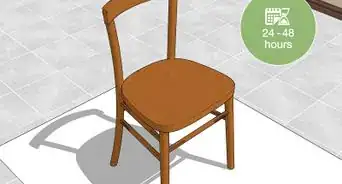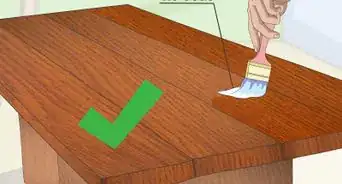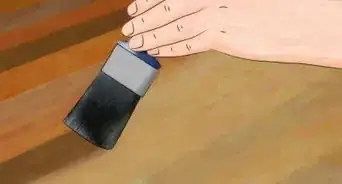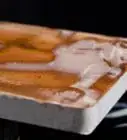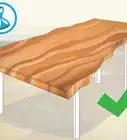wikiHow is a “wiki,” similar to Wikipedia, which means that many of our articles are co-written by multiple authors. To create this article, volunteer authors worked to edit and improve it over time.
wikiHow marks an article as reader-approved once it receives enough positive feedback. In this case, 93% of readers who voted found the article helpful, earning it our reader-approved status.
This article has been viewed 452,278 times.
Learn more...
Wood tends to warp when exposed to moisture and heat. Applying additional moisture and heat to the opposite side of the warp can cause the wood to warp back into its original flat position, effectively “unwrapping” the piece. Minor warping can usually be corrected with heat and moisture only, but for more severe warping, you may also need to apply pressure to the wood.
Steps
Using an Iron
-
1Wrap the wood in moistened towels. Moisten one or two large towels and wrap them around the wood, making sure that the entire warped area is covered.
- The towels you use should ideally be large enough to cover the entire wood piece. Choose towels or rags that can withstand the heat of an iron.
- When moistening the towels, drench them thoroughly and wring out the excess water. The towels should be damp but not dripping wet.
-
2Place the covered wood on an ironing board. Place the wrapped wood on an ironing board or other flat, hard surface. The raised "bubble" should face up.
- The concave or inward curving surface should face down.
- The surface you place the wood on must be rigid. It should also be able to withstand the high heat of an iron.
Advertisement -
3Heat an iron to its highest setting. Turn on a steam iron and switch its temperature setting to the highest point.
- Give the iron two to five minutes to heat up.
- Note that the iron should be designed to work with steam. A dry iron is not recommended.
-
4Press the iron over the warped surface. Press the iron down on one end of the covered wood. Gradually slide it all the way over the entire surface, applying even pressure to the warped area.[1]
- Hold the iron on each spot for 5 to 10 seconds before sliding it to the next spot.
- Each spot should overlap slightly to ensure that the entire wood piece is covered.
- Do not leave the iron unattended at any point. An unattended iron can burn the press towel and the wood beneath it.
-
5Repeat as needed. Check the progress of the wood. If the problem has been corrected, stop here. If some warping remains, repeat the process until the warp is gone.
- Once the wood has un-warped, turn off the iron and unwrap the wood. Allow the wood to dry thoroughly before use.
- This process may not work on severely warped pieces. If you do not notice any progress after two or three tries, you may need to try another method.
Using Sunlight
-
1Wrap the wood in moistened towels. Moisten several large towels and wrap them completely around the warped wood.
- You can use towels, sheets, or rags. The material you use must retain moisture and be large enough to wrap around the warped wood piece.
- Run the towels under water until they are soaked, then wring out as much excess moisture as possible. The material should be moist when you wrap it around the wood, but it should not be drenched.
-
2Place the wood in bright, direct sunlight. Set the wrapped wood out in a warm area that receives a lot of sunlight during the day. The concave (inwardly bent) side should face down and the convex (outwardly bent) side should face up.[2]
- You may want to place a plastic tarp beneath the wood to prevent the water from soaking the surrounding area.
- This method works best during warm, dry weather. It may not work in cold, cloudy, or wet conditions.
- For best results, place the wood on top of a rigid surface, like a driveway or deck. You can place it on top of your lawn, but the process may not be as effective if the wood sits on a soft surface.
-
3Spray with additional water as needed. Depending on the extent of the warping, you will need to keep the wood in sunlight for two to four days. Spray the towels with additional water throughout this period to keep the wood moist.
- As before, the material should only be moist and not dripping wet.
- The sunlight should heat the covered wood and encourage it to absorb moisture from the towels. As moisture is absorbed into the surface, the wood should begin to warp back into its proper position.
-
4Dry until the warping vanishes. The entire process can take several days depending on the damage. Check it regularly. Once the wood is unwarped, remove the wrappings and let it dry.
- When the sun disappears at night, you should bring the wood inside. Keep it in a warm place overnight with the inward curve facing down.
- If you do not notice any progress after a few days, you may need to try a different method.
Using Pressure
-
1Cover the wood with damp paper towels. Moisten several sheets of paper towel and arrange them over the concave (inwardly curved) surface of the wood.
- Paper towels are ideal for this method, but a thin steaming towel or standard paper can also be used. The material you use must be moistened, however, and it must be large enough to cover the entire warped area.
- Rinse the paper towels under water, then carefully wring out the excess. The material should be moist when you drape it around the wood, but it should not be dripping wet.
- Only apply the wet paper towels to the concave side of the wood for this method. By concentrating the moisture on the side, you can help direct the warping back to its original flat position. The concave side will absorb more moisture while the convex (outwardly bent) side will dry out.
-
2Wrap plastic over the paper towels. Wrap several layers of plastic wrap all the way around the wood and the moist paper towels. The plastic wrap must be tight and secure.
- The plastic should slow down the process of evaporation, keeping the paper towels and wood moist for a longer period of time as a result.
- Make sure that the plastic wrap covers all sides of the wood, not just the side covered by paper towels.
-
3Place the wood in a clamp. Place the wood in a clamp, over-tightening the clamp slightly until the warped area begins to straighten out.[3]
- Work carefully while tightening the clamp. If you tighten it too much, the wood might split apart instead of straightening out.
-
4Leave for one week. Keep the wood clamped and wrapped in a warm location for one week.
- Check regularly and remove the wood from the clamp if you see signs of possible damage.
- The storage area should be as warm as possible during this first week. Ideal temperatures would be as high as 149 degrees Fahrenheit (65 degrees Celsius), but if heat that warm is impossible to maintain, the hottest room you have should suffice for most purposes.
- You can keep the wood warmer if you let it sit in direct sunlight, beneath a heat lamp, beneath an electric blanket, or over a warming mat. Keep the heat on the wood for at least six to eight hours per day.
-
5Remove the wrappings. After the first week, remove the wood from the clamp and take off the plastic wrap and paper towels.
- At this point, the wood must be allowed to thoroughly dry.
- Check the progress of the warp. If it has vanished, the wood piece is ready to use as soon as it dries and not additional pressure is needed.
-
6Apply additional pressure. If some warping still remains, return the wood to its clamped position and let it dry that way for two to three weeks.
- The temperature can be somewhat cooler for this stage, but the ideal temperature is still 77 degrees Fahrenheit (25 degrees Celsius).
- The air of the room should also be dry during this stage. Do not store the wood in a humid room.
-
7Check the progress frequently. As soon as the wood has completely dried throughout the entire piece, it should be ready to unclamp and use.
- If the wood has not unwarped after you complete this process, the damage might be too severe to reverse.
Community Q&A
-
QuestionI have a slight warp/curve in a tabletop I'm refinishing. My wonderful and brilliant husband said I could wet the tabletop on both sides and clamp it between 2 boards. Is this true?
 Community AnswerYep, the hubby's right. You may have to do it a bunch of times before the wood fully accepts its straightening, but it works and is done everyday.
Community AnswerYep, the hubby's right. You may have to do it a bunch of times before the wood fully accepts its straightening, but it works and is done everyday. -
QuestionHow do you straighten hard wood that is 1/4th of an inch thick?
 Community AnswerI think only steaming/ironing is your only hope for that thinner stuff. Or, install it damp and with finish screws instead of nails and you'll be perfectly fine.
Community AnswerI think only steaming/ironing is your only hope for that thinner stuff. Or, install it damp and with finish screws instead of nails and you'll be perfectly fine. -
QuestionDo any of these three methods work for GAF composite 2x4 or 1x10 deck lumber?
 Community AnswerI doubt these exact methods would work, due to the amount of plastic in the composite. However, heat would be your best bet. Try wrapping black trash bags around the lumber and setting it in the sun.
Community AnswerI doubt these exact methods would work, due to the amount of plastic in the composite. However, heat would be your best bet. Try wrapping black trash bags around the lumber and setting it in the sun.
Things You'll Need
Using an Iron
- Damp towels
- Ironing board
- Steam iron
Using Sunlight
- Damp towels
- Spray bottle
- Plastic tarp
Using Pressure
- Paper towels
- Plastic wrap
- Clamp
- Heat lamp
References
About This Article
To unwarp a piece of wood, start by wrapping it in 1 or 2 moist towels to protect them from direct heat. Then, place the towel-wrapped wood on an ironing board with the raised warp facing up. Turn your iron to its hottest setting and wait a few minutes for it to heat up. Once your iron heats up, press it down on one end of your covered wood. Hold it in place for 5-10 seconds before sliding it down to the next spot. When you’ve heated all of the warped area, unwrap the wood and check its progress. If it’s still a bit warped, wrap it up again and repeat the process. For more tips, including how to unwarp your wood using direct sunlight and pressure, read on!

